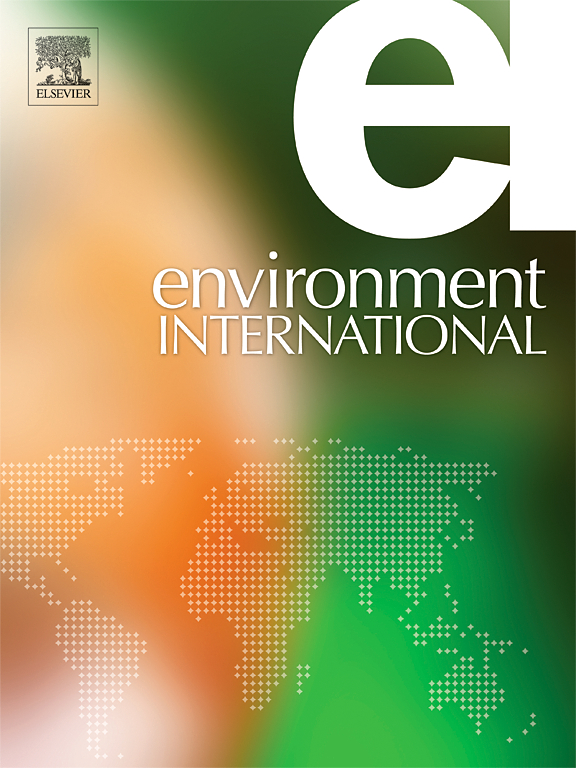PFAS contamination in tap water: Target and suspect screening of zwitterionic, cationic, and anionic species across Canada and beyond
IF 9.7
1区 环境科学与生态学
Q1 ENVIRONMENTAL SCIENCES
引用次数: 0
Abstract
This study investigated the occurrence of perfluoroalkyl and polyfluoroalkyl substances (PFAS), including anionic, cationic, and zwitterionic compounds, in drinking water. Between 2021–2023, an expanded list of 76 target PFAS was screened in tap water samples mainly from Canada, but also including tap water samples from the Eastern United States, Mexico, South America (Argentina), the Caribbean (Dominican Republic, Cuba), Africa (Algeria, Cameroon, Central African Republic, Morocco, Rwanda, Tunisia), Europe (France, Greece, Italy, Spain, and the United Kingdom) and Asia (Japan, Vietnam, Iran, and Türkiye). An additional ∼ 200 suspect-target PFAS were screened using high-resolution Orbitrap mass spectrometry. The results revealed widespread contamination of PFAS in tap water. The most frequent were perfluorobutane sulfonate (PFBS), perfluorooctane sulfonate (PFOS), and perfluorobutanoic acid (PFBA) with detection rates of ≥ 79 %. Several PFAS not currently included in EPA methods for drinking water revealed region-specific trends. For instance, emerging zwitterionic 6:2 fluorotelomer sulfonamidopropyl betaine (6:2 FTAB) was found at the highest levels in cities of France, British Columbia (Canada), and the UK. The occurrence of FTAB likely reflects shifts from PFOS-based aqueous film-forming foams (AFFF) in the past decades, and possibly other uses. Short-chain perfluoroalkyl sulfonamides (FBSA, FHxSA) were also globally recurrent. Bistriflimide, a counterion often used in the composition of ionic liquids and in the production of lithium-ion batteries, was detected in 46 % of the samples. The highest levels of total PFAS in drinking water were linked to contamination from fluorochemical industries (surface water), AFFF use (groundwater), and landfills (groundwater). This database of 275 PFAS x 153 samples provides valuable insights toward refining the lists of relevant PFAS to be monitored in drinking water.


自来水中的PFAS污染:目标和怀疑筛选两性离子,阳离子和阴离子物种在加拿大和超越
本研究调查了饮用水中全氟烷基和多氟烷基物质(PFAS)的存在情况,包括阴离子、阳离子和两性离子化合物。在2021-2023年期间,在自来水样本中筛选了76个目标PFAS的扩大清单,主要来自加拿大,但也包括来自美国东部、墨西哥、南美洲(阿根廷)、加勒比地区(多米尼加共和国、古巴)、非洲(阿尔及利亚、喀麦隆、中非共和国、摩洛哥、卢旺达、突尼斯)、欧洲(法国、希腊、意大利、西班牙和英国)和亚洲(日本、越南、伊朗和土耳其)的自来水样本。使用高分辨率Orbitrap质谱法筛选了另外的 ~ 200个可疑目标PFAS。结果显示自来水中普遍存在PFAS污染。最常见的是全氟丁烷磺酸(PFBS)、全氟辛烷磺酸(PFOS)和全氟丁酸(PFBA),检出率 ≥ 79 %。一些目前未列入EPA饮用水检测方法的PFAS显示出区域特有的趋势。例如,两性离子6:2氟端聚体磺酰胺丙基甜菜碱(6:2 FTAB)在法国、不列颠哥伦比亚(加拿大)和英国的城市中含量最高。FTAB的出现可能反映了过去几十年来基于全氟辛烷磺酸的水性成膜泡沫(AFFF)的转变,也可能反映了其他用途。短链全氟烷基磺酰胺(FBSA, FHxSA)也在全球范围内反复出现。Bistriflimide是一种反离子,通常用于离子液体的成分和锂离子电池的生产,在46%的样品中检测到 %。饮用水中全氟辛烷磺酸总量的最高水平与氟化工工业(地表水)、AFFF使用(地下水)和垃圾填埋场(地下水)的污染有关。这个包含275个PFAS x 153个样本的数据库为完善饮用水中要监测的相关PFAS列表提供了有价值的见解。
本文章由计算机程序翻译,如有差异,请以英文原文为准。
求助全文
约1分钟内获得全文
求助全文
来源期刊

Environment International
环境科学-环境科学
CiteScore
21.90
自引率
3.40%
发文量
734
审稿时长
2.8 months
期刊介绍:
Environmental Health publishes manuscripts focusing on critical aspects of environmental and occupational medicine, including studies in toxicology and epidemiology, to illuminate the human health implications of exposure to environmental hazards. The journal adopts an open-access model and practices open peer review.
It caters to scientists and practitioners across all environmental science domains, directly or indirectly impacting human health and well-being. With a commitment to enhancing the prevention of environmentally-related health risks, Environmental Health serves as a public health journal for the community and scientists engaged in matters of public health significance concerning the environment.
 求助内容:
求助内容: 应助结果提醒方式:
应助结果提醒方式:


